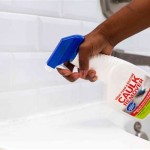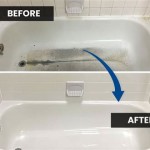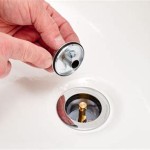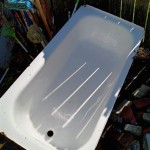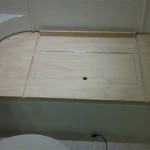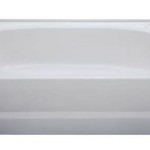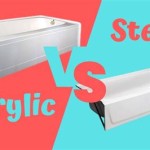Bathtub Water Stopper Stuck: A Comprehensive Guide to Diagnosis and Resolution
A common household plumbing issue arises when a bathtub water stopper becomes lodged in the drain. This predicament can lead to an inability to drain the bathtub, resulting in wasted water, potential overflow, and, if left unresolved, possible water damage to the surrounding area. Understanding the mechanisms behind these stoppers and possessing the knowledge to diagnose and resolve the issue are crucial for maintaining a functional and efficient bathroom.
The malfunction of a bathtub stopper can stem from a variety of factors, ranging from simple obstructions to more complex mechanical failures within the stopper mechanism itself. Hair, soap scum, mineral deposits, and small objects are frequent culprits. These materials can accumulate around the stopper and within the drainpipe, hindering the stopper's ability to move freely. Furthermore, the linkage connecting the stopper to the control lever (if applicable) can become corroded, bent, or disconnected, preventing the stopper from lifting or closing properly. A systematic approach to diagnosis and repair is therefore essential for determining the root cause of the problem and implementing the appropriate solution.
Various types of bathtub stoppers exist, each with its own mechanism and potential failure points. Learning to identify the specific type of stopper installed is the first step in tackling the problem. The most common types include pop-up stoppers, lift-and-turn stoppers, toe-touch stoppers, and trip-lever stoppers. Each type requires a slightly different approach to diagnosis and repair, and understanding these differences is crucial for avoiding further damage to the fixture.
Identifying the Type of Bathtub Stopper
Accurately identifying the type of bathtub stopper present is paramount to addressing the issue effectively. Distinct characteristics define each type, influencing the troubleshooting and repair strategies employed.
Pop-up Stoppers: These stoppers feature a mushroom-shaped cap that sits flush with the drain when closed. They typically operate via a rocker arm mechanism located beneath the drain. A horizontal rod connects the rocker arm to a lever near the overflow drain. When the lever is moved, the rod actuates the rocker arm, which raises or lowers the stopper.
Lift-and-Turn Stoppers: As the name suggests, these stoppers are operated by lifting and turning the stopper itself. A screw mechanism beneath the stopper causes it to expand or contract a rubber gasket, creating a seal against the drain opening. These are often secured with a setscrew which is usually accessed on the side of the stopper after removing the top cap.
Toe-Touch Stoppers: These stoppers, also known as push-and-seal stoppers, are activated by pressing down on the stopper with a toe or finger. Pressing once seals the drain, and pressing again releases it. The internal mechanism typically involves a spring-loaded plunger and a rotating cam.
Trip-Lever Stoppers: These stoppers are controlled by a lever located near the overflow drain. The lever is connected to a linkage system that extends down to the drain. This linkage usually includes a plunger or a pivoting mechanism that seals the drain opening. These are often more complex, and prone to issues within the trip lever mechanism.
Once the type of stopper is identified, a thorough examination of its visible components can often reveal the source of the problem. Look for signs of corrosion, damage, or obstruction around the stopper and its immediate vicinity. This initial assessment can streamline the troubleshooting process and help to prevent unnecessary disassembly.
Troubleshooting Steps for a Stuck Bathtub Stopper
When a bathtub stopper becomes stuck, a methodical approach is necessary for effective troubleshooting. A structured process can help identify the problem's root cause and implement the appropriate solution without causing further damage.
Initial Assessment and Cleaning: Before attempting any disassembly, visually inspect the stopper and the surrounding drain area. Remove any visible debris, such as hair, soap scum, or other foreign objects, using tweezers, pliers, or a thin wire hook. Often, a simple cleaning is sufficient to restore the stopper's function. If the stopper remains stuck after cleaning, proceed to the next steps.
Investigating Pop-Up Stoppers: For pop-up stoppers, the issue often lies with the rocker arm mechanism or the connecting rod. Locate the access plate near the overflow drain and remove it. Use a flashlight to inspect the rod and rocker arm for corrosion, bending, or disconnection. If the rod is disconnected, reattach it. If it is corroded or bent, it may need to be cleaned, lubricated, or replaced. Test the lever's movement to ensure it actuates the rocker arm smoothly. Adjustment screws may be present on the rocker arm to fine-tune the stopper's movement. Check these screws to see if they are loose, or allow for too much free play.
Examining Lift-and-Turn Stoppers: For lift-and-turn stoppers, the issue is often related to the screw mechanism or the rubber gasket. Attempt to gently lift and turn the stopper. If it is completely stuck, use a small flat-head screwdriver to loosen the setscrew (if present) securing the stopper to the drain flange. Once loosened, try lifting the stopper out. Examine the rubber gasket for wear, cracks, or hardening. If the gasket is damaged, it will need to be replaced. Clean the internal screw mechanism with a brush and a cleaning solution to remove any accumulated debris. Lubricate the screw threads with silicone grease to facilitate smooth operation.
Addressing Toe-Touch Stoppers: Toe-touch stoppers can be challenging to troubleshoot due to their internal mechanism. First, try pressing the stopper firmly several times to see if it will release. If this doesn't work, the stopper may need to be disassembled. Some toe-touch stoppers have a removable cap that can be unscrewed to access the internal components. Others may require prying them out carefully. Once the stopper is disassembled, examine the spring-loaded plunger and rotating cam for damage or obstruction. Clean all components thoroughly and lubricate them with silicone grease. Reassemble the stopper and test its function.
Dealing with Trip-Lever Stoppers: Trip-lever stoppers often suffer from issues with the linkage system. Remove the overflow plate to access the linkage. Carefully pull out the linkage and examine it for corrosion, bending, or disconnection. Clean the linkage and the plunger or pivoting mechanism at the end. Lubricate all moving parts with silicone grease. Check the plunger or pivoting mechanism for wear or damage. If it is significantly worn, it may need to be replaced. Reinstall the linkage and test the lever's movement.
Using a Drain Snake: In cases where the stopper is stuck due to a blockage further down the drainpipe, a drain snake (also known as an auger) can be used to clear the obstruction. Carefully insert the drain snake into the drain opening and rotate it to break up or retrieve the blockage. Be cautious not to damage the drainpipe. After snaking the drain, flush it with hot water to remove any remaining debris.
Preventative Measures to Avoid Future Stopper Issues
Preventing future issues with bathtub stoppers requires a proactive approach to maintenance. Regular cleaning and preventative measures can significantly reduce the likelihood of stoppages and ensure the long-term functionality of the drainage system.
Regular Cleaning: The most effective preventative measure is regular cleaning of the stopper and the drain area. Periodically remove the stopper and clean it thoroughly with a brush and a cleaning solution. Remove any accumulated hair, soap scum, or other debris. Flushing the drain with hot water mixed with baking soda and vinegar can also help to dissolve minor blockages.
Hair Catchers and Strainers: Installing a hair catcher or strainer over the drain opening can prevent hair and other debris from entering the drainpipe. These devices are inexpensive and easy to install, and they can significantly reduce the frequency of stoppages. Clean the hair catcher or strainer regularly to prevent it from becoming clogged.
Avoid Pouring Oils and Grease Down the Drain: Avoid pouring oils, grease, or other viscous substances down the bathtub drain. These materials can solidify and accumulate in the drainpipe, causing blockages. Dispose of these materials properly in the trash or recycling.
Periodic Maintenance of Stopper Mechanisms: Periodically inspect and maintain the stopper mechanism, especially for pop-up and trip-lever stoppers. Remove the access plate near the overflow drain and examine the linkage for corrosion, bending, or disconnection. Clean and lubricate all moving parts with silicone grease. Adjust the linkage as needed to ensure smooth and efficient operation.
Flushing with Hot Water: Regularly flushing the drain with hot water can help to prevent the buildup of soap scum and other debris. Run hot water down the drain for several minutes after each bath or shower.
By implementing these preventative measures, homeowners can significantly reduce the likelihood of bathtub stopper issues and maintain a functional and efficient bathroom drainage system. Consistent maintenance not only prevents inconvenient stoppages but also extends the lifespan of the plumbing fixtures.
While addressing a stuck bathtub stopper is often a manageable task for homeowners, certain situations may warrant the expertise of a qualified plumber. If the problem persists despite thorough troubleshooting efforts, or if there is evidence of significant corrosion, damage, or leaks, seeking professional assistance is advisable. Attempting complex repairs without the necessary knowledge and tools can potentially lead to further damage and more costly repairs in the long run.

Bathtub How Can I Remove A Stuck Bath Stopper Assembly Home Improvement Stack Exchange

How To Fix A Stuck Bathtub Drain

Bathroom Repair How To A Pop Up Tub Drain Stopper

How To Remove A Bathtub Drain Stopper Mr Rooter
Bathtub Has Been Extremely Slow Draining Clogged For What Seems Like Years And All Methods We Ve Tried To Fix Draino Snakes Etc Are Inconsistent Any Permanent Solutions Quora

How To Remove A Bathtub Drain The Home Depot

Tub Bath Value Stuck Doityourself Com Community Forums

Fix A Stuck Tub Stopper With The Help Of Wd 40

How To Replace Bathtub Drain Stopper With A Lift And Turn Diy

Bathroom Repair How To A Pop Up Tub Drain Stopper
Related Posts

